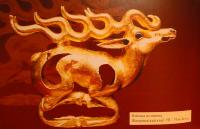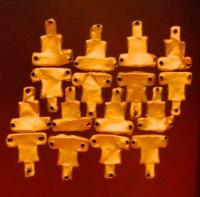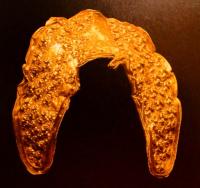Вы здесь
Ancient Gold of Kazakhstan.





Tours behind ancient treasures of Kazakhstan.
"Like many other burial mounds, the ones in Chilikty had been plundered during ancient times. However, the one named "Golden" had retained many interesting findings: remains of a leather quiver with 13 bronze arrowheads, golden plates decorating the quiver, figures of wild boars cut out of golden foil, and many other pieces of small jewelry"
Cultural Journey in Central Asia and Kazakhstan.
Gold is an eternal precious metal and all the nations of the world. Every existing civilization have many legends, happy as well as tragic ones, about gold. From the depths of millenniums past, gold items still intact have been discovered.
Kazakhstan is famous for its gold finds. Archeologists have discovered numerous splendid and well preserved gold items from different eras. Gold for any time the first high quality artistic gold jewelry discov-ered in the territory of Kazakhstan consisted of flat rings, a grivna (necklace) with a half circle on the bottom made of bronze, and a magnificent set of molded earrings.
These were from the bronze era, three or four thousand years ago. Very unusual and high quality decorations were found in Pridzhungarie, in the Mynshunkur burial ground near the village of Kapal.
These were large earrings with small horses which resembled onagers (wild donkeys) one after another inside the earrings. However, the production of high quality artistic gold items flourished at the beginning of the Iron Age when the tribes of nomads, semi-nomads and farmers from Saki, Ussuni, Savromates, Sarmates, Kangui and Hunnes were living in the territory of Kazakhstan.
By that time, the art was thriving among those tribes, with the main characteristic being the "animal style," which in the 7th and 6th centuries ВС spread among the tribes of Siberia, Kazakhstan Central Asia and southern Europe.
These creative works were attributed to the "Scythian-Siberian" style, named after the place of the initial findings which were first in Scythia and then in Siberia. The images were mainly depictions of beasts, animals and zoomorphic monsters, which combine the features of several animals into a kind of mythic creature.
Very often the masters' depictions on the golden decorations were of Caucasian goats, wild rams, wild boars, predators and deer with bent legs or standing on the top of their hoofs. As a rule, the animals had static positions.
However, in the VIth through IVth centuries ВС a new direction of animal art style appeared in the Eurasian steppes with scenes of animals and people's lives on diadems (crowns), belts, earrings and bracelets.
The treasures of Zhalaulinskiy and Kargalinskiy along with the Golden Warrior are the most famous archeological finds. The Zhalaulinskiy treasure was named after the village in Kegenskiy Rayon of the Almaty Oblast, where schoolchildren accidentally found it in 1988.
Jewelry was found in a felt bag which had been buried by treasure hunters at the beginning of the 20th century. The jewelry was mined from a plundered tsar's burial mounds of the Kegen valley.
A massive golden breast adornment, which also covered the shoulders, was found in the bag. Another unusual treasure was found in a burial site at Kargaly gorge not far from Almaty. This site was probably the grave of a shaman lady.
Among the numerous gold findings was a golden diadem depicting animals, birds and people in an interlacing, intricate floral ornament. You could also see a couple of Siberian stags with a bird flying between them, and a winged tiger carrying a human being, along with a rider on the back of a running dragon and a winged horse.
Animals' eyes were made of colored cornelian (red quartz) and almandine (garnet); the bodies were encrusted with turquoise. Scientists presume images of the diadem reflect the religious concepts and mythology of the Ussunies.
The world-famous Issyk burial dates back to the end of the 4th and 3rd centuries ВС, where the symbol of Kazakhstan, the Golden Warrior, was found during excavations of the Issyk burial mound.
The Issyk burial mound is 40 kilometers east of Almaty. This was an incredible find for the scientists as all other burials had been plundered, except this one. Here the deceased was found in the burial crypt on a cloth bedding embroidered with small golden plates, fully armed, dressed in a parade uniform embroidered with gold.
According to anthropologists the deceased was 17 - 18 years old. The golden headdress was embroidered with gold plates; the warrior had a gold spiral grivna on the neck; and gold elements were seen everywhere - on the sword belt, dagger, whip and arrows.
The long outer garment was decorated with about 3,000 golden elements and the trousers, shirt, belt and boots were also embroidered with gold. Kazakhstani archeologists have made many interesting discoveries from studying the burials of noble people and chiefs.
Scientists found amazing samples of the handmade artwork of the ancient people of the country. Great findings were discovered in eastern Kazakhstan in the burial mounds of the Chiliktinskaya valley, where 51 burial sites of ancient chiefs were found.
Like many other burial mounds, the ones in Chilikty had been plundered during ancient times. However, the one named "Golden" had retained many interesting findings: remains of a leather quiver with 13 bronze arrowheads, golden plates decorating the quiver, figures of wild boars cut out of golden foil, and many other pieces of small jewelry.
Chi-liktinskiy burial mound dates back to the VIIth century ВС and is considered the earliest tsar's burial in the northern steppes of Kazakhstan and one of the most ancient in the territory of Eurasia.
The scientists found 4,325 golden items there: 153 plates shaped like a snow leopard's muzzle, 36 plates in the form of a golden eagle, 20 which were deer-shaped, 39 in the form of a wolf or bear cub, a solid wild ram, small bells, earrings, glass beads and others.
The Chiliktinskiy golden items are different from others found in Kazakhstan burials as they are not stamped but cast with inserts of turquoise. Among other gold items found in the different burials, archeologists discovered beautiful funeral (religious) pendants encrusted with colored stones from burials of the IInd and IIIrd centuries AD as well as a bowl and plates of a mosaic belt from the medieval burial mound of Chingildy that dated back to the 8th century AD.
All of these items are considered to be the works of outstanding unknown artists and jewelers and are included in the treasury of the world's culture. You may see them in the Museum of Gold and Precious Metals in Astana, the State National Museum of Almaty and the H. Margulan Archeology Museum.
Authority:
Karl Baipakov. Magazine “Tengri” 1, 2010.







